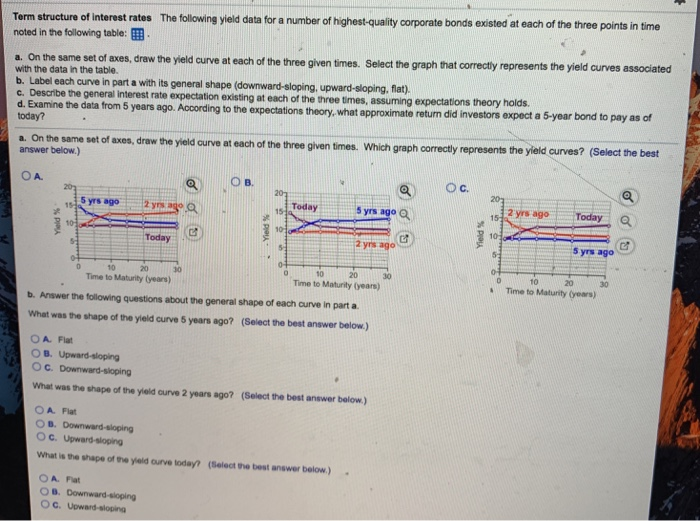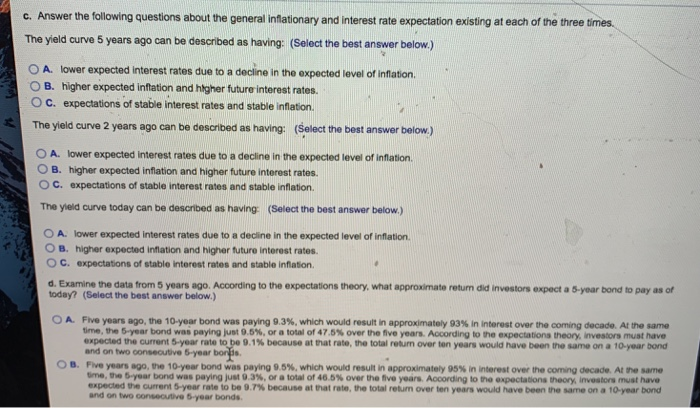Q27
***READ And follow all directions***
Please answer questions with the answers and put the answers in the picture where they belong
Answers only
Please dont make it confusing
Please be clear
Please write or type neatly

Term structure of interest rates The following yield data for a number of highest-quality corporate bonds existed at each of the three points in time noted in the following table: B correctiy represents the yield curves associated a. On the same set of axes, draw the yield curve at each of the three given times. Select the graph that with the data in the table. b. Label each curve in part a with its general shape (downward-sloping, upward-sloping, flat) c. Describe the general interest rate expectation existing at each of the three tmes, assuming expectations theory holds. expect a 5-year bond to pay as of d. Examine the data from 5 years ago. According to the expectations theory,-what approximate return did inve today? a. On the same set of axes, draw the yield curve at each of the three given times. answer below.) Which graph correctly represents the yield curves? (Select the best . 5 yrs ago 2yrs a s Today 5 yrs ago a 2 yrs ago TodayQ Today 2 yrs ago 5 yrs ago 10 20 30 10 20 30 10 20 30 Time to Maturity (years) Time to Maturity (years) Time to Maturity (years) s b. Answer the following questions about the general shape of each curve in part a. What was the shape of the yield curve 5 years ago? (Select the best answer below.) O A. Flat O B. Upward-sloping OC. Downward-sioping What was the shape of the yield curve 2 years ago? (Select the best answer below) O A. Flat O B. Downward-sloping O c. Upward-sloping What is the shape of the yield curve today? (Select the best answer below.) O A. Fiat B. Downward" ping O C. Upward-sloping c. Answer the following questions about thegeneral inftationary and interest rate expectation existing at each of the three times. The yield curve 5 years ago can be described as having: (Select the best answer below.) O A. lower expected interest rates due to a decline in the expected level of inflation. O B. higher expected inflation and higher future interest rates O c. expectations of stable interest rates and stable inflation. The yield curve 2 years ago can be described as having: (Select the best answer below.) 0 A. lower expected interest rates due to a decline in the expected level of inflation. OB. higher expected inflation and higher future interest rates O C. expectations of stable interest rates and stable inflation. The yield curve today can be described as having: (Select the best answer below.) A. O B. higher expected inflation and higher future interest rates O C. expectations of stable interest rates and stable inflation. lover expected interest rates due to a decline in the expected ieved of inflation. d. Examine the data from 5 years ago. According to the expectations theory, what approximate retum did investors expect a S-year bond to pay as of today? (Select the best answer below.) O A. Five years ago, the 10-year bond was paying 9.3%, which would result in approximately 93% in interest over the coming decade. At the same ne, the 5-year bond was paying ust 9.5%, or a total of 47.5% over ne five years. Accoring to he expectations theory, i vesors must have expected the current 5-year rate tobe 9.1%because at rat rate, the total reum over ten years would have been the same on a layar bord and on two consecutive 6-year bonss Five years ago, the 10-year bond was paying 9 5%, which would result in approximately 95% in interest over the coming decade Al re same tme, the 5-year bond was paying just 9 3%, or a total of 46 5% over the five year. According to re .xpectations toon invelor, must have expected the current 5-year rate to be 9 7% because at rat rate, re total return over ten years would have been the same on a 10-year bond and on two consecutive 6 year bonds OB. Click on the icon located on the top-right corner of the data table below in orde to copy its contents into a spreadsheet.) Yield Time to maturity (years) 5 years ago 2 years ago Today 1 3 9.1 % 9.2 9.3 9.5 9.4 9.3 9.4 14.6% 12.8 12.2 10.9 10.7 10.5 10.5 9.3 % 10 15 20 30 9.8 10.9 12.6 12.7 12.9 13.5









